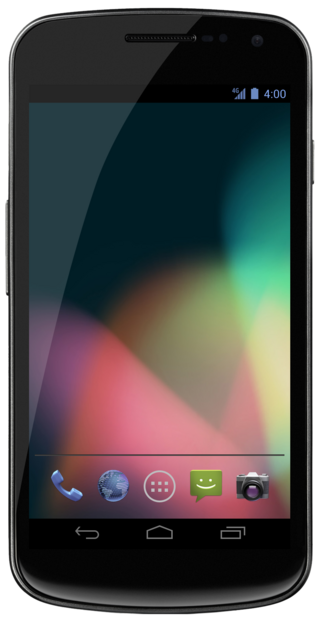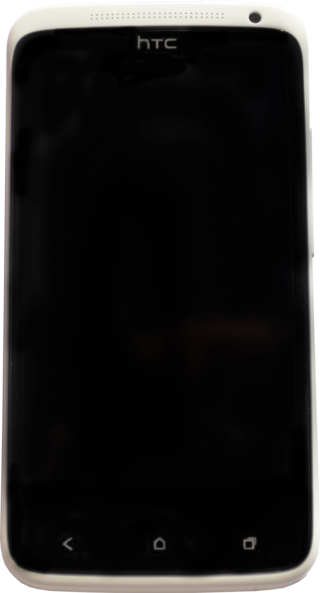Related Research Articles

The Motorola Razr is a series of mobile phones by Motorola, part of the 4LTR line. The V3 was the first phone shown in the series and was introduced in December 2003 and released in the market in the third quarter of 2004. The V3 model was followed soon thereafter by the improved V3i, including a collaboration with Apple Inc. for iTunes to be built-in. It was launched in 2006.
Motorola Mobility LLC, marketed as Motorola, is an American consumer electronics manufacturer primarily producing smartphones and other mobile devices running Android. It is a subsidiary of the Chinese multinational technology company Lenovo.
The Droid series of phones are exclusive to Verizon Wireless. The branding "Droid" is a registered trademark of Lucasfilm that is licensed for Verizon's use. Many of these phones are also sold in other countries under different names ; see under the individual articles for details.
MSM7000 is a series of system-on-a-chip processors manufactured by Qualcomm for handheld devices, especially smartphones.

The Droid X is a smartphone released by Motorola on July 15, 2010. The smartphone was renamed Motoroi X for its release in Mexico on November 9, 2010. The Droid X runs on the Android operating system, and the latest version supported was 2.3 Gingerbread. It was distributed by Verizon Wireless in the United States and Iusacell in Mexico.
Google Nexus is a discontinued line of consumer electronic devices that run the Android operating system. Google managed the design, development, marketing, and support of these devices, but some development and all manufacturing were carried out by partnering with original equipment manufacturers (OEMs). Alongside the main smartphone products, the line also included tablet computers and streaming media players; the Nexus started out in January 2010 and reached its end in October 2016, replaced by Google Pixel.

The Motorola Droid Bionic is an Android-based, 4G LTE-capable smartphone designed by Motorola. It was originally scheduled for release in Q2 2011 but was delayed, eventually being released on 8 September 2011.

The HTC ThunderBolt (ADR6400L) was the first 4G LTE smartphone on the Verizon Wireless network. It is a CDMA/LTE variant of the HTC Desire HD. It was first announced at CES on January 6, 2011.

The Galaxy Nexus (GT-I9250) is a touchscreen Android smartphone co-developed by Google and Samsung Electronics. It is the third smartphone in the Google Nexus series, a family of Android consumer devices built by an original equipment manufacturer partner. The phone is the successor to Google's previous flagship phones, the Nexus One and Nexus S.

The Verizon Droid Razr is an Android-based, 4G LTE-capable smartphone designed by Motorola that launched on Verizon Wireless on November 11, 2011. It was announced on October 18, 2011 in New York City.

The Motorola Droid 4 (XT894) is a smartphone made by Motorola Mobility. It was released with Android 2.3 and can be upgraded to Android 4.1. It was released on Verizon Wireless's network on February 10, 2012. It is the successor to Motorola's Droid 3, and is one of the first smartphones to support GLONASS in addition to GPS.

The HTC One X is a touchscreen-based, slate-sized smartphone designed and manufactured by HTC. It was released running Android 4.0.3, with the HTC Sense 4.0 skin. The One X is powered by the NVIDIA Tegra 3 for most international GSM carriers, making this the first HTC phone to be equipped with a quad-core processor, while a variant which is LTE capable is powered by the Qualcomm Snapdragon S4 dual-core 1.5 GHz Krait processor. The One X was announced on February 26, 2012 at the Mobile World Congress and was HTC's sixth flagship product, leading the HTC One series from the time of its release through April 2013, when its successor the HTC One (M7) was announced.
The Droid Incredible 4G LTE, also known as the HTC Incredible 4G or Incredible 3, is a smartphone designed and manufactured by Taiwan's HTC Corporation that runs the Android 4.0 operating system (ICS). Officially announced by Verizon on May 7, 2012, for CTIA, and released on July 5, 2012, through Verizon Wireless for $149.99 with a new two-year contract. The Droid Incredible 4G LTE is the successor to the HTC Incredible S.
The Motorola Photon Q 4G LTE (XT897) is a smartphone manufactured by Motorola which runs on Sprint's 4G LTE network. The "Photon Q" has a 4.3-inch touchscreen and a 1.5 GHz dual-core processor. It runs the Android operating system and includes a built-in, sliding keyboard similar to the one on the Motorola Droid 4.

The Droid Razr M is an Android-based, 4G LTE-capable smartphone designed by Motorola as a smaller successor to the Droid Razr. It was advertised as "The full screen phone" with thin edges, though it lacked a robust resolution. It came with a light skin of Android for Verizon Wireless (XT907), SoftBank Mobile (XT902), and Telstra as well as an unbranded retail version for the Australian market. The Electrify M (XT901) for U.S. Cellular is a CDMA handheld with a different housing, but otherwise same specification as the Razr M.

The Droid Razr HD and Droid Razr Maxx HD are Android-based, 4G LTE-capable smartphones designed by Motorola as the successor to the Droid Razr series released nearly a year prior. Notable changes from their predecessors include 720p resolution displays and increased display size while maintaining similar overall dimensions. Additionally, the battery capacity on the standard Razr HD is 42% larger than its predecessor. Both go by the model number XT926. These phones were released on October 18, 2012 exclusively on Verizon Wireless in the United States. The Motorola Razr HD were available as international or global phones in Europe, Latin America, Australia and Canada as early as October 2, 2012. In the summer of 2013, storyboards surfaced of television commercials that have not yet aired. These commercials will feature the Droid Maxx and Droid Ultra, the apparent successors to the Droid Razr Maxx HD and Droid Razr HD, respectively.

The HTC Butterfly is an Android-based, 4G LTE-capable smartphone designed and developed by HTC. First announced for release in Japan by Japanese carrier KDDI as the HTC J Butterfly (HTL21), the J Butterfly was released in Japan on 9 December 2012 as the successor to the HTC J. Outside Japan, in other Asian countries, the phone was released as the HTC Butterfly (X920d) and in China and Russia as the HTC Butterfly (X920e). The Chinese/Russian and US versions of the Butterfly do not have a microSD slot. In the United States, the Butterfly was released as the HTC Droid DNA as a Verizon exclusive, supporting wireless charging. The DNA would become Verizon's final non-Motorola Droid smartphone; following its replacement in August 2013 by the HTC One and Droid Maxx, the carrier announced that all future Droid phones would be built exclusively by Motorola. In June 2013, the Butterfly was succeeded by the HTC Butterfly S.
The Droid Maxx is a smartphone developed by Motorola Mobility. It is the first Droid to be a high end smartphone exclusively developed by Motorola for Verizon Wireless. It is part of the Verizon Droid line, and was announced on 23 July 2013 along with the Droid Ultra and Droid Mini at a joint Motorola and Verizon Wireless press conference.
The Motorola Razr (2019) is an Android foldable smartphone produced by Motorola Mobility. Unveiled on November 14, 2019, it was released on February 6, 2020. The device is designed to be reminiscent of the original Motorola Razr feature phone series and features a horizontally foldable screen.
References
- ↑ "HTC Rezound confirmed ahead of Thursday's announcement". geek.com. Nov 1, 2011. Archived from the original on January 3, 2012. Retrieved November 1, 2011.
- ↑ Agomuoh, Fionna. "Samsung Galaxy Nexus, Motorola Droid Razr and HTC Rezound Releases Make November 'Android Month'". Christian Post. Archived from the original on 29 October 2011. Retrieved 1 November 2011.
- ↑ "HTC Rezound for Verizon unveiled". Engadget.com. Nov 3, 2011. Archived from the original on January 17, 2016. Retrieved August 29, 2017.